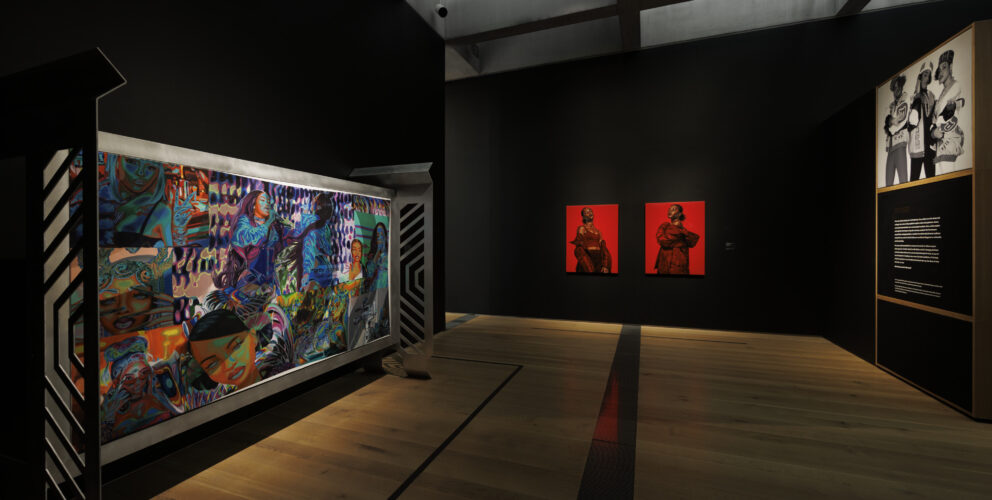Adrian Octavius Walker, American, born 1988; A Great Day in St. Louis, 2022; archival pigment print; 18 x 36 inches; Courtesy the artist; © Adrian Octavius Walker
On the morning of August 8, 1958, American artistic director and photographer Art Kane gathered 57 of the world’s greatest jazz soloists. The musicians, 54 men and three women, posed on the stoop of 17 East 126th Street in Harlem, laughing and reconnecting all the while. Across the street, Kane stood with his camera, unaware of the history he was about to make. The photo, A Great Day in Harlem, was later featured as the centerfold in the January 1959 issue of Esquire and became the namesake of an Oscar-nominated documentary.

Art Kane, American, 1925–1995; A Great Day in Harlem, August 12, 1958; © Art Kane Archive
The iconic photo has continued to inspire artists across the globe for the past 70 years. Photographers have created homages in several cities, including Hollywood, Philadelphia, Kansas City, Jersey City, Saint Paul, and Houston. There was even a Dutch version, titled A Great Day in Haarlem.
Forty years after the original photo was taken, groundbreaking photographer Gordon Parks gathered 177 of the most influential rappers and hip hop producers on the same Harlem brownstone stoop as an homage to Kane’s work. His A Great Day in Hip Hop was published on the cover of XXL Magazine in 1998. It was a moment of reckoning for the hip hop community, having lost two giants two years before—Tupac Shakur was killed in 1996 and Biggie Smalls in 1997. There was also concern about potential drama in bringing rappers together from both coasts because of Tupac and Biggie’s East Coast/West Coast rivalry, but there was none.
A few of the many notables in the 1998 photo include Grandmaster Flash, Jermaine Dupri, Busta Rhymes, Wyclef Jean, and Questlove.

Gordon Parks, American, 1912–2006; A Great Day in Hip Hop, Harlem, New York, 1998; © The Gordon Parks Foundation
In looking back over 50 years of hip hop history, the curatorial team for The Culture: Hip Hop and Contemporary Art in the 21st Century asked: What might this image look like in our own communities?
St. Louis photographer Adrian Octavius Walker took on the project, capturing 116 St. Louis rappers, DJs, producers, and more, posed together on Art Hill. The photograph, A Great Day in St. Louis, is featured at the exit of The Culture, bookended by the 1998 A Great Day in Hip Hop that greets exhibition visitors.
“Creating A Great Day in St. Louis was simply an act of paying homage to the legends before me,” Walker said. “I knew I couldn’t pull this work off alone, so I contacted key individuals in the city—Mvstermind, SieNote, Tef Poe, Corey Black, and Kevin Johnson.”
Unlike his predecessors’ black-and-white images, Walker chose to capture A Great Day in St. Louis in color, showcasing members of the local hip hop community against the vibrant green of Forest Park.
“What made me decide to photograph the image in color was the thought about the location first and foremost. Art Hill is one of the most iconic places on the planet to me. The rich history and beautiful landscape are like no other,” Walker said, emphasizing the allure of the colors and iconic symbolism of St. Louis–branded merchandise.
“A Great Day in St. Louis should happen often; that is the image’s primary goal: to bring everyone together and show the city, and cities outside St. Louis, what togetherness looks and feels like.”

Adrian Octavius Walker in front of his work A Great Day in St. Louis at the exit of The Culture: Hip Hop and Contemporary Art in the 21st Century
This historic photo acts as a seamless through line in African American culture and Black sound. It celebrates hip hop’s brilliant legacy and encourages viewers to consider the evolution of music.
The Baltimore Art Museum, the exhibition’s co-organizing institution, created its own version of the photo for The Culture, titled You Can’t Raid the Sun by Baltimore-based photographer Devin Allen. Featuring members of that city’s hip hop community, this image is shot in black and white against a brownstone stoop.
To view A Great Day in Hip Hop, A Great Day in St. Louis, and You Can’t Raid the Sun in context with the rest of the exhibition, visit The Culture, open through January 1.
